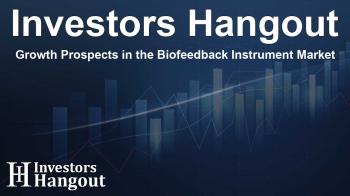Growth Prospects in the Biofeedback Instrument Market

Understanding the Biofeedback Instrument Market
In the ever-evolving landscape of healthcare, the biofeedback instrument market is one sector that has captured significant attention. With a rapid upward trajectory, this market is set to grow and evolve in ways that promise impressive returns and enhanced healthcare solutions. By leveraging real-time data, biofeedback devices empower users to gain control over their physiological responses, making a remarkable impact on various health conditions.
Current Market Value and Growth Rate
The biofeedback instrument market was valued at approximately USD 194 million recently and is projected to escalate to around USD 340 million by the end of the forecast period in 2034. This growth reflects a compound annual growth rate (CAGR) of about 6.2%. Such a trend indicates a flourishing industry driven by advancements in technology and increasing awareness among consumers.
Innovative Product Development
Technological enhancements have quietly transformed biofeedback devices from traditional tools into sophisticated, user-friendly instruments. Innovations in sensor technology and data processing have allowed the integration of multiple physiological indicators into a single platform. This progress facilitates comprehensive monitoring of heart rate variability, muscle tension, brainwave activity, and more, ultimately enhancing treatment outcomes for users.
Applications Driving Market Demand
The applications of biofeedback technology span across several sectors, including healthcare facilities for pain management, mental health treatments, and sports performance optimization. Hospitals, clinics, and home healthcare providers increasingly incorporate biofeedback devices to improve patient outcomes - highlighting the technology's versatility and efficacy.
Consumer Market Dynamics
As wellness trends gain traction, consumers are gravitating towards accessible solutions for stress management, performance enhancement, and overall well-being. Wearable technology and portable devices have made biofeedback more accessible to general consumers, breaking down barriers associated with traditional clinical settings. This growing consumer market is a significant contributor to the projected growth rate.
Regional Insights and Trends
Regionally, North America and Europe lead in the adoption of biofeedback technology, primarily due to robust healthcare infrastructures and advanced clinical practices. However, the Asia-Pacific region presents compelling growth prospects, fueled by increasing consumer awareness and healthcare investments, indicating a gradual shift in market dynamics.
Challenges and Market Barriers
Despite its growth potential, the biofeedback instrument market faces hurdles such as regulatory challenges, reimbursement restrictions, and the need for consumer education. These factors can stifle adoption rates if not addressed adequately, particularly in developing regions where healthcare investments are sparse.
SWOT Analysis Overview
To truly understand the landscape of the biofeedback market, a SWOT analysis provides crucial insights:
- Strengths: Strong scientific backing, non-invasive treatment options, wide applicability across different health issues.
- Weaknesses: High costs associated with professional-grade systems and variances in insurance coverage can limit access.
- Opportunities: The rise of digital health and telemedicine platforms provides new avenues for reaching consumers.
- Threats: Competition from alternative therapies and regulatory changes pose risks to market growth.
Future Outlook
With a positive outlook and innovation continuously shaping the landscape, the global biofeedback instrument market is poised to thrive in the years to come. Strategic collaborations between tech developers and healthcare providers could enhance product effectiveness, driving further market penetration.
Frequently Asked Questions
What is the projected growth rate of the biofeedback instrument market?
The biofeedback instrument market is expected to grow at a CAGR of approximately 6.2%, reaching USD 340 million by 2034.
What applications are driving the demand for biofeedback devices?
Applications include pain management, stress alleviation, muscle rehabilitation, and enhancements in sports performance.
Which regions are leading the biofeedback instrument market?
North America and Europe are at the forefront, while Asia-Pacific is projected to show the highest growth potential.
What technological advancements are being made in biofeedback?
Technological innovations focus on improving sensor capability, data analytics, and the integration of multiple monitoring features into singular devices.
What challenges does the biofeedback market face?
Challenges include regulatory complexities, reimbursement issues, and the need for enhanced consumer education and training.
About The Author
Contact Lucas Young privately here. Or send an email with ATTN: Lucas Young as the subject to contact@investorshangout.com.
About Investors Hangout
Investors Hangout is a leading online stock forum for financial discussion and learning, offering a wide range of free tools and resources. It draws in traders of all levels, who exchange market knowledge, investigate trading tactics, and keep an eye on industry developments in real time. Featuring financial articles, stock message boards, quotes, charts, company profiles, and live news updates. Through cooperative learning and a wealth of informational resources, it helps users from novices creating their first portfolios to experts honing their techniques. Join Investors Hangout today: https://investorshangout.com/
The content of this article is based on factual, publicly available information and does not represent legal, financial, or investment advice. Investors Hangout does not offer financial advice, and the author is not a licensed financial advisor. Consult a qualified advisor before making any financial or investment decisions based on this article. This article should not be considered advice to purchase, sell, or hold any securities or other investments. If any of the material provided here is inaccurate, please contact us for corrections.

